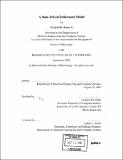| dc.contributor.advisor | Leonard McMillan. | en_US |
| dc.contributor.author | Matusik, Wojciech, 1973- | en_US |
| dc.contributor.other | Massachusetts Institute of Technology. Department of Electrical Engineering and Computer Science. | en_US |
| dc.date.accessioned | 2014-05-23T19:32:48Z | |
| dc.date.available | 2014-05-23T19:32:48Z | |
| dc.date.issued | 2003 | en_US |
| dc.identifier.uri | http://hdl.handle.net/1721.1/87454 | |
| dc.description | Thesis (Ph. D.)--Massachusetts Institute of Technology, Dept. of Electrical Engineering and Computer Science, 2003. | en_US |
| dc.description | "September 2003." | en_US |
| dc.description | Includes bibliographical references (leaves 112-115). | en_US |
| dc.description.abstract | I present a data-driven model for isotropic bidirectional reflectance distribution functions (BRDFs) based on acquired reflectance data. Instead of using analytic reflectance models, each BRDF is represented as a dense set of measurements. This representation allows interpolation and extrapolation in the space of acquired BRDFs to create new BRDFs. Each acquired BRDF is treated as a single high-dimensional vector taken from the space of all possible BRDFs. Both linear (subspace) and non-linear (manifold) dimensionality reduction tools are applied in an effort to discover a lower-dimensional representation that characterizes the acquired BRDFs. To complete the model, users are provided with the means for defining perceptually meaningful parametrizations that allow them to navigate in the reduced-dimension BRDF space. On the low-dimensional manifold, movement along these directions produces novel, but valid, BRDFs. By analyzing a large collection of reflectance data, I also derive two novel reflectance sampling procedures that require fewer total measurements than standard uniform sampling approaches. Using densely sampled measurements the general surface reflectance function is analyzed to determine the local signal variation at each point in the function's domain. Wavelet analysis is used to derive a common basis for all of the acquired reflectance functions, as well as a non-uniform sampling pattern that corresponds to all non-zero wavelet coefficients. Second, I show that the reflectance of an arbitrary material can be represented as a linear combination of the surface reflectance functions. Furthermore, this analysis specifies a reduced set of sampling points that permits the robust estimation of the coefficients of this linear combination. | en_US |
| dc.description.abstract | (cont.) These procedures dramatically shorten the acquisition time for isotropic reflectance measurements. | en_US |
| dc.description.statementofresponsibility | by Wojciech Matusik. | en_US |
| dc.format.extent | 115 leaves | en_US |
| dc.language.iso | eng | en_US |
| dc.publisher | Massachusetts Institute of Technology | en_US |
| dc.rights | M.I.T. theses are protected by copyright. They may be viewed from this source for any purpose, but reproduction or distribution in any format is prohibited without written permission. See provided URL for inquiries about permission. | en_US |
| dc.rights.uri | http://dspace.mit.edu/handle/1721.1/7582 | en_US |
| dc.subject | Electrical Engineering and Computer Science. | en_US |
| dc.title | A data-driven reflectance model | en_US |
| dc.type | Thesis | en_US |
| dc.description.degree | Ph.D. | en_US |
| dc.contributor.department | Massachusetts Institute of Technology. Department of Electrical Engineering and Computer Science | |
| dc.identifier.oclc | 54927347 | en_US |
